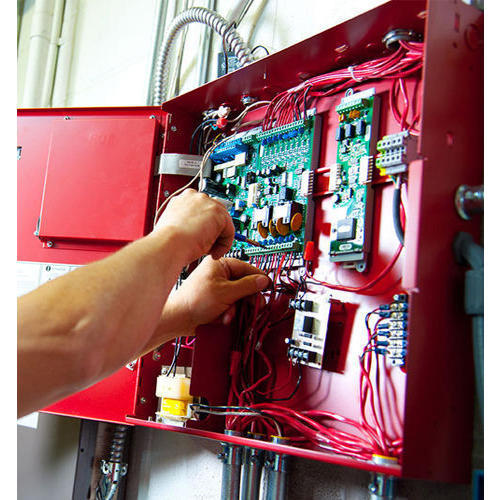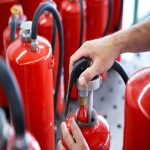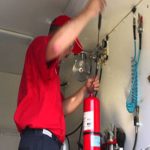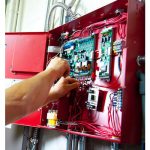Mediland offers complete system repair services for all types of fire protection systems. Our Service Department has over 60 technicians trained to service fire alarm systems and sprinkler systems. In addition to fire alarm and sprinkler system repairs, our fire suppression system department is expertly qualified to repair and service all types of clean agent systems including FM200, Carbon Dioxide (CO²), Inergen, NOVEC 1230 as well as many other clean agents.
Our emergency repair technicians are available 24 hours a day and we maintain a large, modern fleet of vehicles to assure prompt and efficient service. Most repair parts are readily available on these vehicles. If not, our 9000 square foot warehouse stocks a wide variety of OEM parts. All fire extinguisher repair work and hydrostatic testing is done in our DOT certified maintenance shop by Mediland employees. We don’t subcontract any of these tasks. In fact, other fire protection companies use Mediland for fire extinguisher repairs and hydrostatic testing.
Our Service Department has the following capabilities:
Repairs, renovations and additions to all types of fire protection systems
24 hour emergency service with a 2 hour response time in Delhi Area
Guaranteed same day service for systems emergencies
Guaranteed next day service for empty fire extinguishers
Repair and recharge for large capacity wheeled fire extinguishers and fixed dry chemical systems
Emergency recharge services for restaurants
It is our core belief is that superior service, attention to detail and unmatched experience add value for customers for whom system readiness, reliability, and performance are of the utmost importance. Mediland’s experience as a provider of Quality Fire Protection Service & Solutions is one of the key benefits we provide to our customers.
How Do I Maintain a Fire Alarm System?
Once a properly designed and installed fire alarm system is in place in your building the most important single thing you can do to ensure reliable operability in the event of a fire is to inspect, test and maintain the system. National Fire Protection Association Standard 72, National Fire Alarm Code, identifies the component inspection and test methods required for all devices in the system. Your local jurisdiction may require different frequencies than the ones that are noted below.
Visual inspection frequencies include weekly, monthly, quarterly, semi-annual and annual activities. These generally can be performed by competent building maintenance personnel. In fact, it’s quite rare that a licensed fire protection company performs these inspections. Mediland can provide visual inspection training for maintenance personnel so that this important function is performed properly.
Functional testing must be performed by trained experienced personnel. Functional testing requirements are quite different from those for visual inspections. As the description implies, functional testing involves the actual operation of all devices in the system to ensure proper operation. Functional testing frequencies range from semi-annual to annual but the code notes that local authorities may require more frequent testing. A typical fire alarm testing contract includes annual testing for all fire alarm devices with semi-annual testing for certain sprinkler devices that send alarm or supervisory signals to the fire alarm system (supervisory signals indicate an “off-normal” condition of a device or subsystem).
Smoke detectors are tested using simulated spray smoke in the sensing chamber of the detector. Manual pull stations are operated by actually pulling the device. These devices (and all others) are required to initiate an alarm signal within a predetermined interval. When the system is in an alarm condition a technician will walk around to make sure all notification (horns, horn/strobe lights, bells, speakers, etc.) are operating properly. There are also various functional tests that must be performed on the control panel such as verifying proper receipt of trouble, supervisory, and alarm signals, batteries, digital communicator, annunciators and special suppression systems connected to the fire alarm system.
Semi-annual fire alarm testing is required for certain sprinkler system components connected to the fire alarm system. Control valve switches, more commonly known as “tamper switches” send a supervisory signal to the system when the valve is closed. Testing is done by closing the valve a prescribed distance to see if a signal is received. Waterflow switches are mechanical devices that sense water moving through sprinkler piping and initiate an alarm signal on the system. Water is flowed through the system using a valve opening called an inspectors test connection, simulating the flow of one sprinkler head.
Using a licensed fire protection contractor that employs NICET (National Institute for the Certification of Engineering Technicians) certified technicians is the best way to ensure the reliable operation of your fire alarm system. This is a critical factor to make sure your fire alarm system is there for you in the unlikely event of a fire.



